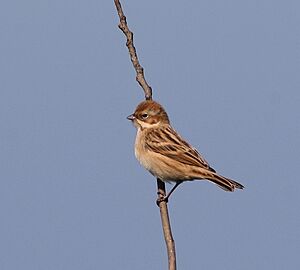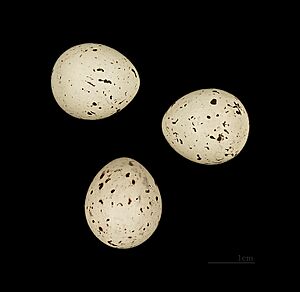Pallas's reed bunting facts for kids
Quick facts for kids Pallas's reed bunting |
|
|---|---|
 |
|
| Conservation status | |
| Scientific classification | |
| Synonyms | |
|
The Pallas's reed bunting (Emberiza pallasi) is a small bird. It is also known as Pallas's bunting. This bird is a type of passerine bird. Passerines are often called "perching birds." The Pallas's reed bunting belongs to the bunting family.
Buntings are a group of birds that mostly eat seeds. Most modern scientists now see them as different from finches. This bird is found across northern and central Asia.
Contents
About Pallas's Reed Buntings
The Pallas's reed bunting is part of the Emberizidae bird family. This family has about 300 types of birds that eat seeds. Most of these birds live in North and South America.
However, the Emberiza group, which has over 40 members, lives in the Old World. The Pallas's reed bunting is closely related to the Japanese reed bunting and the common reed bunting.
Where the Name Comes From
The name Emberiza comes from an old German word. This word means "bunting." The English name and the scientific name pallasii honor a German scientist. His name was Peter Simon Pallas. He was an explorer and naturalist.
Where They Live and Travel
Pallas's reed buntings breed in northern and central Asia. This includes places like Mongolia. They are migratory birds. This means they travel to warmer places for winter.
They spend their winters in Southeast Asia. Sometimes, they fly very far west. They have even been seen in Great Britain. This is very rare for them.
Different Types of Pallas's Reed Buntings
There are three main types, or subspecies, of Pallas's reed bunting:
- E. p. polaris: This type lives in northeast European Russia and north Kamchatka. It spends winter in eastern China.
- E. p. pallasi: This type is found in Mongolia and Transbaikalia. It winters in west and north China.
- E. p. lydiae: This type lives in south Siberia and northern Mongolia. It spends winter in north China.
What is Their Habitat?
Pallas's reed buntings like to live near water. They are common in tundra areas with small bushes. They also breed in dry, open places. This includes open larch forests.
What Do They Look Like?
The Pallas's reed bunting is a small bird. It looks a lot like a small common reed bunting. It has a small beak that is good for eating seeds.
The male bird has a black head and throat. It has a white collar around its neck. Its belly is also white. Its back is grey with many streaks. The common reed bunting has a browner back.
The female bird looks much duller. She has a streaked brown head. Her underside has fewer streaks than a female common reed bunting.
Their Song
The male Pallas's reed bunting has a special song. It is a repeated sound that sounds like "sherp."
What Do They Eat?
The Pallas's reed bunting's diet changes. When they are feeding their young, they mostly eat insects. At other times, they mainly eat seeds.
Reproduction and Life Cycle
Pallas's reed buntings breed between June and August. Birds in the northern parts of their range breed earlier. They build their nests in bushes.
The nest is usually made from grasses and sedges. They line the inside with softer materials. These can be smaller grasses or animal hair. The female lays 3 to 5 cream-colored eggs.
The eggs have thin, hair-like markings. These marks are common on bunting eggs. The eggs hatch after about 11 days.



